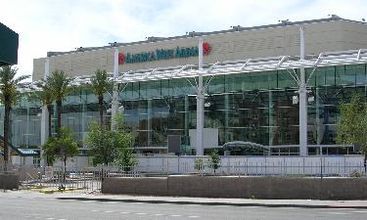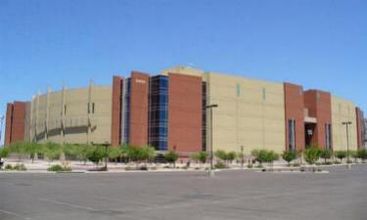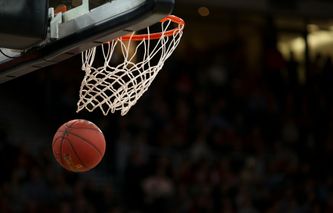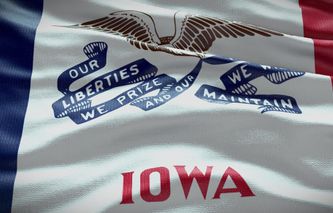24th Season
First Game Played October 5, 1996
5800 W. Glenn Drive, Suite 350Glendale, AZ 85301
Tel. (623) 463-8800

Historical Moments
1996/97:Though they were the first NHL team in Phoenix, hockey had been played in the valley of the sun for over 20 years, going back to the WHA’s Roadrunners who played from 1974-1977. After the WHA folded, the Roadrunners became a minor league team until the arrival of the Coyotes sent them running out of town. After splitting their first two games on the road, the Coyotes beat the San Jose Sharks in front of a sold-out America West Arena 4-1 in the first regular-season NHL game played in Phoenix. Led by Keith Tkachuk, who would score 52 goals, the Coyotes would make the playoffs by finishing in third place in the Central Division with a 38-37-7 record. In the playoffs, the Coyotes fans would continue a tradition that started in Winnipeg by wearing all white to home playoff games. However, the Coyotes would also maintain a Jets tradition by losing their first-round series to the Mighty Ducks of Anaheim in seven games.
1997/98:On December 14th, Mike Gartner would make history in a 5-3 win over the Maple Leafs in Toronto by becoming just the 5th player in NHL history to score his 700th career goal joining Wayne Gretzky, Gordie Howe, Marcel Dionne, and Phil Esposito. With Keith Tkachuk again leading the way in goals with 40, the Coyotes would make the playoffs by finishing in 4th place with a record of 35-35-12. However, it would be another quick exit as they re beaten by the Detroit Red Wings in 6 games. Following the season, the Coyotes milestone maker Mike Gartner would announce his retirement ending a Hall of Fame career, which goes back to his days as a Cincinnati Stinger in the WHA.
1998/99: Playing in the Pacific Division after realignment divides the NHL from four to six divisions, the Coyotes send four players Nikolai Khabibulin, Teppo Numminen, Jeremy Roenick, and Keith Tkachuk to the All-Star Game, on the way to finishing in second place with a solid record of 39-31-12. In the playoffs, the Coyotes would continue to play strong hockey as they jumped out to a 3-1 series lead over the St. Louis Blues. However, the Blues would rally to win the next three games to take the series in seven games. After blowing a 3-1 series lead coach, Jim Schoenfeld was chosen as the fall guy as he was fired and replaced by Bobby Francis.
1999/00:Under new coach Bobby Francis, the Coyotes continued to play solid hockey posting a 39-35-12-4 record for their 5th straight playoff appearance going back to their final year in Winnipeg. However, the Coyotes would fail to reach the second round again as the Colorado Avalanche buries them in five games. Following the season, the Coyotes would be sold to an ownership group headed by the greatest player ever to play the game, Wayne Gretzky.
2000/01:While Wayne Gretzky was trying to get the funding for his purchase, it appeared as if the Coyotes future in Phoenix could be in jeopardy, especially if they could not get financing for a new arena. With financial troubles, the Coyotes were forced to trade away captain Keith Tkachuk to the St. Louis Blues at the trade deadline. Without Tkachuk, the Coyotes would fall just short of making the playoffs despite posting a respectable 35-27-17-3 record. After the season, the Coyotes would lose another star in Jeremy Roenick, who signs a free-agent deal with the Philadelphia Flyers. However, they would secure their future as plans to build a new arena in the Phoenix suburb of Glendale, were approved by voters.
2001/02:Despite cuts in the team’s payroll, the Coyotes play solid hockey all season as goalie Sean Burke revitalizes his career with a solid 2.29 GAA posting a solid record of 40-27-9-6, falling just five points short of their first division title since joining the NHL. However, in the playoffs, the Coyotes would come back down to earth as they are beaten by the San Jose Sharks in five games.
2002/03:Coming off their surprisingly strong season, the Coyotes went out and landed one of the big free agent catches of the offseason in Tony Amonte. However, Amonte would be one of the biggest free-agent busts in NHL history as he only posts 36 points in 59 games before he is traded to the Philadelphia Flyers for Guillaume Lefebvre, and two draft picks. Making matters worse, the Coyotes saw a total of 462 man-games lost to injuries, including Goalie Sean Burke who only appeared in 22 games. With all that loss, the Coyotes would suffer their worst season since moving to Phoenix finishing in fourth place with a 31-35-11-5 record.
2003/04:It was a year of new beginnings for the Coyotes who had new uniforms and a new den as they began to play in the Glendale Arena on December 27th. Before their new arena opened, the Coyotes played mediocre hockey posting a 10-11-11-1 record. The Coyotes first game in Glendale ended in disappointment as they lost to the Nashville Predators 3-1. However, a few days later, goalie Brian Boucher would make NHL history as he did not allow a goal in five straight games establishing a new NHL record streak of 332:01 minutes without allowing a goal. However, after the streak ended, the Coyotes’ struggles resumed as they continued to skate at .500. In February, the struggles went from bad to worse as the Coyotes won just twice, leading to the firing of Coach Bobby Francis. With Rick Bowness leading the team the rest of the season, the Coyotes would go on to finish in last place with a record of 22-36-18-6.
2004/05:Season Cancelled Due to Lockout
2005/06:Coming out of the Lockout, the most significant buzz in Phoenix centered around the Coyotes new coach, who was none other than “The Great One” Wayne Gretzky. In addition to Gretzky behind the bench, the Coyotes signed future Hall of Famer Brett Hull. However, at the age of 41, and a year off, Hull was a shadow of his former self and decided to retire after just five games. Meanwhile, the Coyotes got off to a slow start winning only one of their first six games. The Coyotes showed signs of improvement in November but struggled again in December as Gretzky dealt with the death of his mother. Things would get tougher for The Great One and the Coyotes in the New Year, as Gretzky’s name was linked to a Gambling Ring in New Jersey. The ring would see Assistant Coach Rick Tocchet, and be forced to leave the team, while is surfaced, that Wayne Gretzky’s Wife Actress Janet Jones, was making six-figure wagers on sporting events, including the Super Bowl. Meanwhile, amidst the distractions, the Coyotes continued to struggle and were never a factor in the playoff race finishing in last place in the Pacific Division with a record of 38-39-5.
2006/07:As the season began, it was clear the Coyotes were a team looking toward the future, as talent-wise, they did not measure up to many teams in the NHL. To help make up for the gap, the Coyotes welcomed back Jeremy Roenick, who starred in the early years in the desert. They would also land defenseman Ed Jovanovski, who had an all-star pedigree, and Owen Nolan, who was making a comeback after sitting out two years. For most of the first two months, the Coyotes struggled, winning just four of their first 16 games. As the New Year began the Coyotes played their best hockey winning seven straight beginning with a home and home sweep of the San Jose Sharks. The winning streak would allow the Coyotes to climb back to .500 at 20-20-2. However, it would not last as the Coyotes would begin losing again, with a six-game losing streak in February, as they decided to trade veterans Ladislav Nagy and Mike Comrie for prospects. However, as a consequence, the Coyotes would struggle down the stretch winning just four of their final 19 games, as they finished in last place again with a terrible record of 31-46-5.
2007/08:Coming off an awful season, there was no place to go, but up for the Coyotes, helping them start the move forward was rookies Peter Mueller and Martin Hanzal, who each had a solid first year in the NHL, as the Coyotes showed some early signs of improvement. However, still lacking to find a reliable number one goalie, the Coyotes acquired Ilya Bryzgalov off waivers from the Anaheim Ducks on November 17th. After initially struggling, Bryzgalov gave the Coyotes just the spark they needed as they had a solid road trip in which they won five of six, beating playoff contenders like the New York Rangers, New Jersey, Devils, Philadelphia Flyers, and San Jose Sharks. As the New Year began, the Coyotes continued to play well starting a five-game winning streak on December 31st, as they climbed over .500. The Coyotes would stay in playoff contention until March when a five-game losing streak ended their hopes of making the postseason; However, there 38-37-7 record had to be considered a significant improvement.
2008/09:On the ice, the Coyotes were anything but exceptional as they struggled again, finishing in fourth place with a 36-39-7 record, as they were never in the race for the playoffs. However, off the ice was a more significant concern for Coyotes fans in Phoenix, as the team was forced to ask the league for financial assistance. Reports had stated the Coyotes had lost $200 million since 2001. Eventually, the Coyotes holding company Dewey Ranch Hockey LLC was forced to file Chapter 11 Bankruptcy. This would lead to a bid from Canadian Billionaire Jim Balsillie, who wanted to move the team to Hamilton, Ontario. However, NHL Commissioner Gary Bettman wanted to ensure the team remained in the desert, so he attempted to broker a deal to bring in Jerry Reinsdorf to buy the Coyotes. However, after the deal fell apart, Balsillie again tried to snatch the team back to Canada, even attempting to bring the case to court. While the Coyotes future was in turbulence, Coach Wayne Gretzky decided to resign, leaving Dave Tippett to coach the team. Eventually, the NHL would arrange to purchase the club for $140 million, to stabilize its future in Arizona.
2009/10:Under new coach Dave Tippett, the Coyotes began the season with questions about their future as the league continued to seek new owners, intending to keep the team in the desert. Despite the issues over the team’s future, the Coyotes got off to a solid start, winning six of their first eight games as they went on to post a 9-4 record in October. After struggling most of November, the Coyotes started moving forward again after Thanksgiving, as they went on a five-game winning streak. As the New Year approached, the Coyotes were still playing strong hockey as they held a record of 25-13-3. Despite a rough start to the month, the Coyotes won ten games in January and found themselves battling for the top record in the Western Conference. The Coyotes would hit the Olympic break with a record of 37-21-5, as General Manager Don Maloney received permission from the league to make improvements at the trade deadline. Among the players acquired by the Coyotes were Derek Morris, Wojtek Wolski, Mathieu Schneider, Lee Stempniak, and Alexandre Picard. The deals had a positive effect right away as they won nine straight games. However, they would lose four of their last five games in March and were playing catch up to the San Jose Sharks for the rest of the season. The Coyotes would win three of four in April as they reached the playoffs for the first time in eight years with a franchise-best record of 50-25-7. However, they would settle for the fourth seed as they finished six points behind the Sharks for the Pacific Division title and the best record in the Western Conference. Coach Dave Tippett would win the Jack Adams Trophy as Coach of the Year, while Goalie Iyla Bryzgalov was a finalist for both the Hart Trophy and Vezina as the best goalie and NHL MVP. In the playoffs, the Coyotes had an unlucky draw as they faced the Detroit Red Wings, who had a long championship pedigree. The Coyotes meanwhile had still not won a playoff series since 1987 when they were the Winnipeg Jets. In the opener, things started well for the Coyotes as they won 3-2 on Derek Morris’s power-play goal in the 3rd Period. However, it was not without a cost as Captain Shane Doan suffered an injury that would force him to miss most of the rest of the series. The Wings would bounce back with a 7-4 win in Game 2. The Coyotes would rebound to win Game 3 in Detroit 4-2, but after losing the next two games, the Coyotes were back at Joe Louis Arena facing elimination in Game 6. With three power-play goals and a shorthanded goal, the Sharks kept their hopes of winning a series alive as they won 5-2 to send the series back to Glendale for a seventh game. However, Game 7 would be another letdown as the Red Wings won 6-1, powered by four goals in the 2nd Period. Despite their best season since joining the NHL, the Coyotes still lost money and struggled with the lowest attendance in the NHL as their future in Phoenix remained in doubt. One thing that emerged was the possibility the team could move back to Winnipeg, as an ownership group began to make overtures to have them play at the MTS Centre home of the AHL’s Manitoba Moose.
2010/11:Despite continued uncertainty about their future, the Coyotes remained committed to having a competitive team on the ice, as they signed Ray Whitney during the off-season. The Coyotes would begin the season in Prague, splitting a pair with the Boston Bruins. The Coyotes would make their home opener a week later, losing to the Detroit Red Wings in overtime 2-1. The Coyotes would go on to post a 3-4-3 record in the season’s first month. In November, a seven-game winning streak would highlight a solid 8-3-2 mark. After a mediocre December, the Coyotes started the New Year on the right foot, getting at least one point for a regulation tie in their first eight games. Off the ice, things were not as smooth, as a group from Winnipeg continued to pursue bringing the Coyotes back north, while Jim Balise continued his desire to bring them to Hamilton. A consortium of investors led by Chicago investor Matt Hulsizer would reach a deal with the NHL to purchase the Coyotes along with a lease agreement with Glendale. However, that deal would also later collapse. The Coyotes would have another eight-game winning streak in February as they did not allow the ownership problems to distract them. The Coyotes would win nine games in March as they would go on to reach the playoffs for the second straight season, posting a solid 43-26-13. As the playoffs began, rumors were swirling that the Coyotes were on their way back to Winnipeg. The Coyotes would face the Detroit Red Wings for the second straight season in the first round, dropping the first two games on the road, as Captain Shane Doan was unable to play due to injury. Coming back to the desert, the Coyotes continued to fall short of the mark, losing 4-2 in Game 3, as the Wings went on to sweep the series. The Coyotes would not move to Winnipeg, as the group that tried to revive the Jets ended up doing so by buying the Atlanta Thrashers and moving them to Winnipeg. Still, without an owner and an uncertain future, the team needed a $25 million payment from the City of Glendale to stay in Arizona for the 2011/12 season. Even with the payment, the Coyotes’ lack of an owner keeps them skating on thin ice in the desert.
2011/12:As the Coyotes continued to wander the desert in search of an owner, Quebec City emerged as a player in the bid to bring another team back to a loyal Canadian market that lost a team during the ’90s. Despite a stable owner, and a commitment to build a new arena in Quebec, Commissioner Gary Bettman remained fiercely loyal to all the fans in Arizona, who have stood by the Coyotes through the bankruptcy melodrama. However, new trouble arrived on the scene as the Goldwater Institute objected to the City of Glendale, paying any more money to keep the red ink Coyotes in the desert. Meanwhile, Matthew Hulsizer, who had been trying to buy the team, dropped out of the bidding, meaning the Coyotes would play another season on NHL Welfare. With the continued financial troubles, the Coyotes would lose Goalie Ilya Bryzgalov and Ed Jovanovski. They would reacquire Daymond Langkow in a trade for Lee Stempniak, who was sent to the Calgary Flames in return, while they signed Raffi Torres and Goalie Mike Smith to two-year contracts looking to make the best out of a bad situation. After splitting their first three games on the road, the Coyotes faced the Winnipeg Jets in their home opener, winning 4-1. The Coyotes would play well early in the season, as they posted winning records in October and November. However, as December arrived with a 4-1 loss to the new Jets in their return trip to Winnipeg, the Coyotes began to struggle, as they entered the New Year with a record of 19-16-4. The slump would continue in January, as their playoff hopes looked to be drying up. As February arrived, the Coyotes were reborn, winning 11 of 12 games, with their lone defeat coming in overtime to the Vancouver Canucks. Behind the Coyotes surge was the play of Goalie Mike Smith, who was named the first star of the month. The surge would take them from out of the bottom to the top of the Pacific Division. The streak also convinced management to add extra talent, as they picked up Antoine Vermette from the Columbus Blue Jackets in a trade for Curtis McElhinney and two draft picks. However, just as March began, the Coyotes hit a brick wall, losing five straight and six of seven games. The Coyotes would finish the month strong as they were in a mad for team scramble for the three spots, including the Pacific Division Championship. With Mike Smith stopping 54 shots in an April 3rd game against the Blue Jackets, the Coyotes would win the division with a record of 42-27-13, as they won their last five games. This marked the first time the franchise had finished in first place since joining the NHL, including their years in Winnipeg. The top players for the Coyotes included the ageless Ray Whitney, who led the team to win 77 points, while Radim Vrbata led the team with 35 goals.
2012 Playoffs:After winning their first division championship, the Coyotes faced the Chicago Blackhawks in the first round. The series had a theme, and it was working overtime, with the first five games going into sudden death, tying a record set by the Montreal Canadiens and Toronto Maple Leafs in the 1951 Stanley Cup Finals. The Coyotes would win the opener in Glendale 3-2 as Mike Smith saved 43 of 45 shots, and Martin Hanzal scored the game-winner. After the Blackhawks won 4-3 in Game 5, the Coyotes took Game 3 in Chicago 3-2 with Mikkel Boedker. The game was marred by an ugly hit by Raffi Torres on Martin Havlat. Torres would be suspended 25 games, including the remainder of the postseason and the start of the next season. Boedker would be the hero again, as the Coyotes took a 3-1 series lead, with another 3-2 win in Game 4. However, with a chance to close the series at home, the Coyotes suffered their own overtime heartbreak, losing 2-1 in Game 5. However, back in Chicago, the Coyotes would win their first playoff series since 1987, as Mike Smith blanked the Blackhawks 4-0, stopping all 39 shots in Game 6. In the second round, the Coyotes faced the Nashville Predators and again found themselves in overtime tied 3-3. With Mike Smith stopping 39 of 42 shots, the Coyotes would win 4-3 as Ray Whitney provided the winning goal. With Captain Shane Doan lead the way, the Coyotes would also win Game 2 in Glendale 5-3. As the series shifted to Nashville, the Coyotes suffered their first shutout loss of the postseason, 2-0. In Game 4, they would return the favor as Mike Smith stopped all 25 shots, with Doan scoring the lone goal in a 1-0 win to take a 3-1 series lead. With another chance to close a series at home, the Coyotes would come through, winning 2-1 with Smith stopping 32 shots to send Phoenix, who began the season with their future in doubt to the Conference Finals. All through the postseason, the drama continued, surrounding the Coyotes future, as momentum for them staying began to turn in their favor. In the Conference Finals for the first time in franchise history, the Coyotes faced the Los Angeles Kings. The Coyotes would play poorly in the first two games, as the Kings jumped out to a 2-0 series lead, winning 4-2 and 4-0. As the series shifted to Los Angeles, the Coyotes continued to struggle, losing 2-1 as they managed only 19 shots on goal. The Coyotes would fight off a sweep by winning 2-0 in Game 4, as Mike Smith was magical with stop all 36 shots. Back in Glendale in Game 5, the Coyotes would play in overtime again, this time there were no heroes for the desert dogs, as the Kings won 4-3 on a goal by Dustin Penner to advance to the Stanley Cup Finals which they would win. The Coyotes run would secure another bidder, as Greg Jamison, a former owner of the San Jose Sharks, agreed to buy the team. Based on several contingencies surrounding the arena and getting a bailout from the team’s debts, which has turned the entire drama into a political hot potato throughout the state of Arizona, especially in Glendale.
2012/13:Following their trip to the Western Conference Finals, any momentum the Coyotes could have carried forward was blunted by a lockout that delayed the start of the season for more than three months. While the NHL battled the Players for a new Collective Bargaining Agreement, the future of the Coyotes remained in doubt as members of the Glendale City Counsel wanted more for their money as the Coyotes continued to hemorrhage financially. At the same time, cities like Seattle and Quebec continued to make offers for the team to relocate. When the season finally began in January, the Coyotes struggled, winning just two of their first eight games. The Coyotes would turn things around in February and got back in the playoff picture by winning four of their first six games in March. However, a seven-game winless streak all but doomed a return to the postseason. Injuries were a big part of the Coyotes struggle as they played nearly two weeks without Goalie Mike Smith, who was key to their success in their playoff run. With the playoffs a long shot, the Coyotes were sellers at the trade deadline trading Steve Sullivan, Rafi Torres, and Matthew Lombardi to playoff contenders for prospects and draft picks. However, the Coyotes would not go down quietly as they posted a 7-3-3 record in April as they missed the playoffs by just four points with a record of 21-18-9. Following the season, the Coyotes managed to secure their future in Arizona, as the City of Glendale, after a long debate, agreed to a new 15-year lease with the Coyotes by a slim 4-3 vote on July 2nd. This allowed the NHL to finally sell the team to Renaissance Sports and Entertainment (RSE) for $225 million. The agreement has the city of Glendale giving RSE $15 million US a year for management fees. There is an agreement that RSE can move the team after five years if it accrues $50 million US in losses. In addition, the team would become the Arizona Coyotes following the 2013/14 season.
2013/14:With their future in Arizona somewhat secure, the Coyotes hoped they could begin to win over more fans. However, they continued to be one of the lowest drawing teams in the league. Despite the struggles to draw fans, the Coyotes started the season strong, winning four of their first six games, including an impressive 4-1 win over the New York Rangers on Opening Night at Jobbing.com Arena. The Coyotes continued to play well into November, as they held a 14-4-3 record on November 16th. However, wins would become much scarcer over the six weeks as they closed December with a record of 20-10-9. The Coyotes’ struggles would only get worse in 2014, as they lost six of their first seven games in January as they went into the Olympic Break with a record of 27-21-10. The Coyotes would make one significant move at the trade deadline, sending Chris Brown and Rostislav Klesla to the Washington Capitals for Martin Erat and John Mitchell. With the playoffs slipping away, the Coyotes three-month slump ended, as they won seven of nine games to get back in the playoff race in March. The Coyotes would win five games on the road in March, more than they won in December, January and February combined. However, the Coyotes would win just one game in April, and miss the playoffs, as they finished the season with a record of 37-30-15. Keith Yandle was the Coyotes leading scorer, with 53 points behind 45 assists as Antoine Vermette had a team-best 24 goals.
2014/15:As part of the agreement with the City of Glendale, the franchise becomes the Arizona Coyotes, to draw a broader fan base in the great Phoenix metropolitan area. However, selling desert dwellers on hockey remained difficult, especially with a team that thirsted for wins. Off the ice, they continued to be Glendale’s unwanted tenant as the city remained unhappy with the deal struck to keep the team in Arizona. A local public-relations firm sued IceArizona, the owner of the Phoenix Coyotes, alleging that the NHL club had reneged on a sponsorship deal worth nearly $250,000. A Coyotes spokesman responded to this issue by calling it a “quarter-million-dollar scheme.” IceArizona would sell off controlling interest in the team as the season began, selling 51% of the Coyotes to Philadelphia-based entrepreneur Andrew Barroway. The Coyotes struggled all season as sparse crowds made it feel as if a tumbleweed would come bouncing by at the newly reminted Gila River Arena. As the trade deadline approached, a mass exodus was underway in Arizona, as the Coyotes made several trades that helped boost playoff contenders. No deal had a more significant impact than the January 14th trade that sent Goalie Devan Dubnyk to the Minnesota Wild. Dubnyk helped the Wild find the consistency in goalie they lacked all season and make a significant second-half charge that needed in the second round. Keith Yandle was sent to the New York Rangers and made several big plays on the way to the Eastern Conference Finals, while Antoine Vermette helped the Chicago Blackhawks capture the Stanley Cup. The Coyotes would finish with the worst record in the Western Conference at 24-50-8, which also was their worst record since moving to Arizona. After the season, the Glendale counsel attempted to terminate the team’s deal with the city, citing that two former city employees were involved in securing the deal and later worked for the Coyotes. Eventually, the city would settle on a two year deal with the unwanted team. Meanwhile, fans thirsting for hockey in Quebec still watched on in stunned disbelief.
2015/16:Coming off their worst season since moving to the desert, the Arizona Coyotes looked to begin clawing their way back to respectability in the NHL as they celebrated their 20th season. The Coyotes showed some early positive signs, as they won their first three games and held a solid record of 13-9-1 at the end of November. Two rookies were responsible for Arizona’s early success Max Domi and Anthony Duclair, who clicked on the same line earning the nickname “Killer D’s.” Domi, a 2013 draft pick and son of former Winnipeg Jet Tie Domi, had 52 points ranking second on the team behind Oliver Ekman-Larsson’s 55 points, while Duclair, who was acquired in the Keith Yandle deal had 20 goals. As December began, the Coyotes began to return to reality as they suffered through a winless five-game road trip. After ending December with a record of 18-16-4, the Coyotes started 2016 strong, with points in their first six games as overtime losses sandwiched a four-game winning streak. One player of note in January was John Scott, a journeyman who played in just 11 games, but due to a viral internet campaign was selected by fans to be captain of the Pacific Division All-Star team in the NHL’s new All-Star division tournament format. Embarrassed by the campaign, the Coyotes traded Scott, who had just one point on the season to the Montreal Canadiens on January 15th. Scott was then sent down to the minors, as the NHL attempted to block him from representing Arizona in Nashville. However, fan pressure won out, and John Scott was the captain of the Pacific Division All-Stars. Scott would score two goals in the semifinal and named the All-Star MVP in a story that was too strange to be fiction. After the All-Star break, the Coyotes hardly looked like All-Stars as they posted a 3-10-1 record in February and ended the month amid a seven-game losing streak. While the Coyotes played better in March, their playoff hopes were long gone as they finished fourth in the Pacific Division and fourth in the Wild Card hunt with a record of 35-39-8.
2016/17:After making some strides in 2016, the Arizona Coyotes looked to take another step forward and make the playoffs. After starting the season with a 4-3 win over the Philadelphia Flyers in overtime, the Coyotes hopes for a good season took a series hit as they lost their next five games on an Eastern road trip. Arizona played better in November but found themselves in another slump as the New Year began with the Coyotes in an eight-game losing streak. Holding a record of 11-21-5 as January began, the Coyotes played better in 2017, but the hole they dug proved to be too deep, as they finished the season with a 30-42-10. Radim Vrbata would be Arizona’s leading scorer with 55 points and a team-best 20 goals. Following the season, coach Dave Tippett would be relieved of his duties. The end of the season also marked the end of an era for the Coyotes as longtime captain Shane Doan retired after 21 seasons, spent entirely with the Coyotes franchise, dating back to their final season in Winnipeg.
2017/18:It was a new start for the Arizona Coyotes, as Rick Tocchet replaced Dave Tippet after eight seasons behind the bench. After straight seasons without the playoffs, the Coyotes began remaking their roster as they underwent many changes, most notably the retirement of longtime captain Shane Doan, who had been with the team since they played in Winnipeg. The new-look Coyotes got off a miserable start, losing their first 11 games. The Coyotes nearly went winless in October, before they beat the Philadelphia Flyers 4-3 in overtime. Through 20 games, the Coyotes were an NHL-worst 2-15-3. The losses continued to mount for Arizona until the end of December, as they held a record of 9-27-5 as the calendars changed. A six-game losing streak in December a five-game losing streak in January created a long season for the Coyotes who resembled an expansion team, as the expansion Vegas Golden Knights were in first place. In February, things began to look up for the Coyotes, who put together a five-game winning streak which carried over into March. The Coyotes would win ten games in March, which included wins over Vegas and the Tampa Bay Lightning, who were among the best teams in the NHL. The Coyotes would remain the worst team in the Western Conference as they finished with a record of 29-41-12. The strong finish gave reason for hope for better days ahead as rookie Clayton Keller was the team’s leading scorer with 65 points, including a team-best 23 goals and 42 assists.
2018/19:After their strong finish, the Arizona Coyotes looked to continue the momentum as Oliver Ekman-Larsson was named team captain. The Coyotes improved play continued to shine as they ended October on a five-game winning streak, and hovered near .500 until the start of December. As with many young teams, things are feast or famine as they have their ups and downs. December brought the downs for the Coyotes, as they lost seven of eight games and went into the New Year at 17-20-2. The Coyotes would get back on track in January, and found themselves in the race of the playoffs in the Western Conference. The Coyotes would win 13 of 17 games heading into March and appeared to be in a strong position, holding on to a wild card spot. However, the Coyotes ran out of gas as they endured a five-game losing streak. The Coyotes would win just three of their final 11 games and finished four points behind the Colorado Avalanche for the second wild card with a record of 39-35-8. Darcy Kuemper established himself as Arizona’s top goaltender as he posted a record of 27-20-8 with a 2.33 GAA and a .925 save percentage. Scoring would be an issue for the Coyotes, as Clayton Keller led the way with 47 points, while nobody on the team reached 20 goals. Veterans Brad Richardson and Alex Galchenyuk each had 19 goals to lead the Coyotes.
Coyotes Arenas
Coyotes Legends
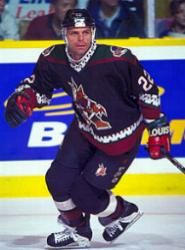 Mike Gartner 1996-1998 | 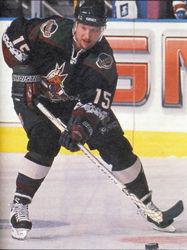 Craig Janney 1996-1998 | 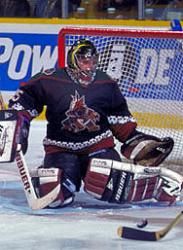 Nikolai Khabibulin 1996-1999 | 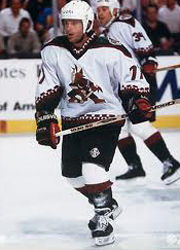 Cliff Ronning 1996-1999 | 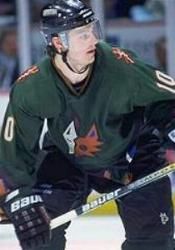 Oleg Tverdosky 1996-1999 | 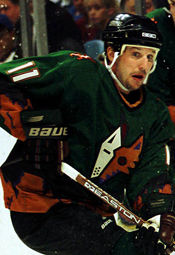 Dallas Drake 1996-2000 |
 Rick Tocchet 1997-2000 |  Greg Adams 1998-2000 | 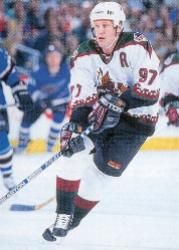 Jeremy Roenick 1996-2001, 2006/07 | 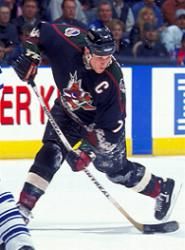 Keith Tkachuk 1996-2001 | 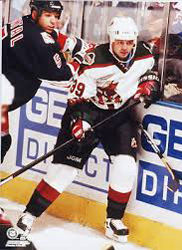 Travis Green 1999-2001 |  Teppo Numminen 1996-2003 |
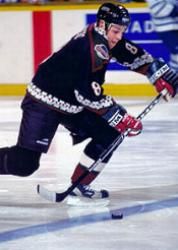 Daniel Briere 1997-2003 | 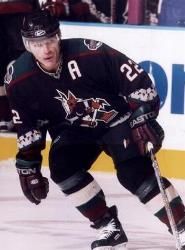 Claude Lemieux 2000-2003 | 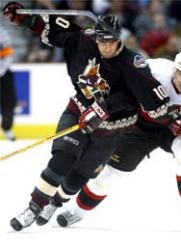 Tony Amonte 2002/03 | 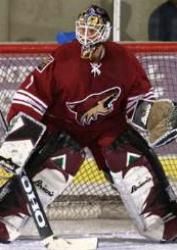 Sean Burke 1999-2004 | 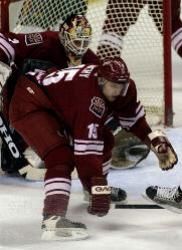 Radoslav Suchy 1999-2004 | 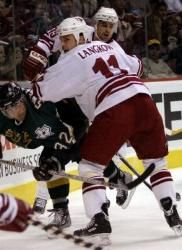 Daymond Langkow 2001-2004, 2011/12 |
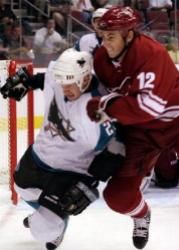 Mike Johnson 2000-2006 | 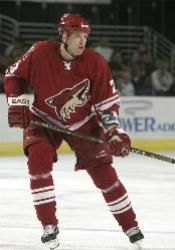 Paul Mara 2000-2006 | 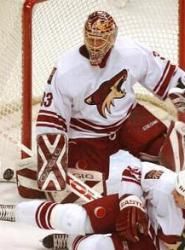 Brian Boucher 2002-2006 | 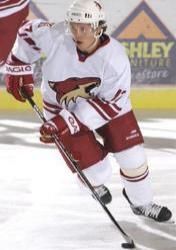 Ladislav Nagy 2000-2007 | 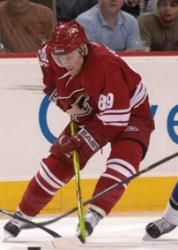 Mike Comrie 2003-2007 | 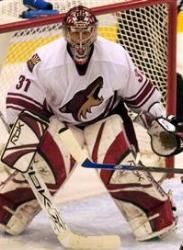 Curtis Joseph 2005-2007 |
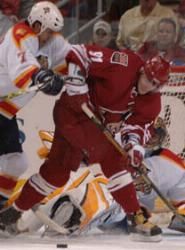 Oleg Saprykin 2005-2007 | 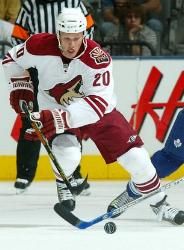 Fredrik Sjostrom 2003-2008 | 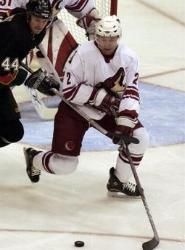 Keith Ballard 2005-2008 |  Wayne Gretzky Coach 2005-2009 | 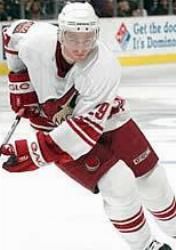 Steve Reinprecht 2005-2009 |  Mikael Tellqvist 2006-2009 |
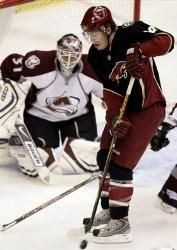 Peter Mueller 2007-2010 | 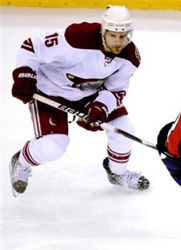 Matthew Lombardi 2008-2010 |  Ed Jovanovski 2006-2011 |  Scotte Upshall 2008-2011 |  Ilya Bryzgalov 2007-2011 | 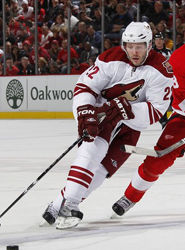 Lee Stempniak 2009-2011 |
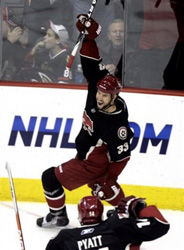 Adrian Aucoin 2009-2012 | 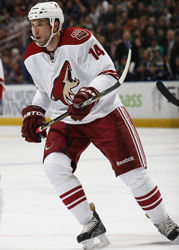 Taylor Pyatt 2009-2012 | 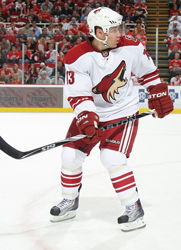 Ray Whitney 2010-2012 |  Raffi Torres 2011-2013 | 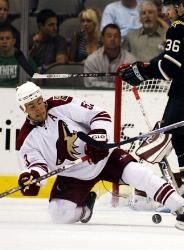 Derek Morris 2003-2009, 2010-2014 | 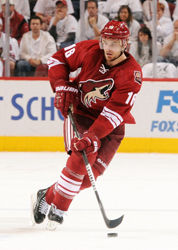 Rostislav Klesla 2009-2014 |
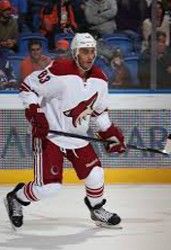 Mike Ribeiro 2013/14 | 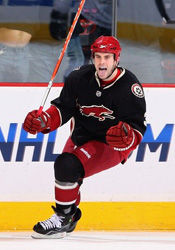 Keith Yandle 2006-2015 | 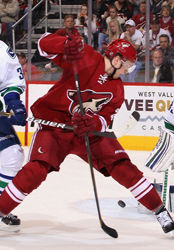 Lauri Korpikoski 2009-2015 | 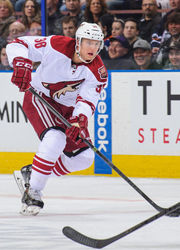 Rob Klinkhammer 2012-2015 | 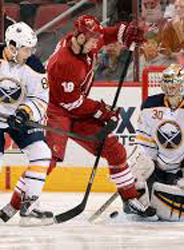 David Moss 2012-2015 |  Martin Erat 2013-2015 |
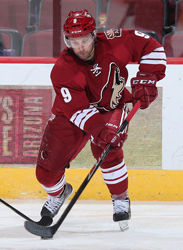 Sam Gagner 2014/15 | 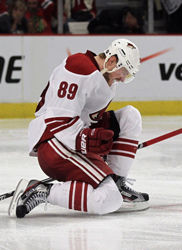 Mikkel Boedker 2008-2016 | 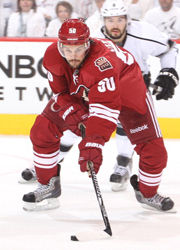 Antoine Vermette 2011-2016 | 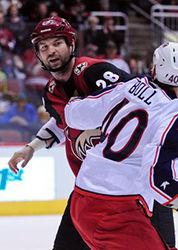 John Scott 2015/16 | 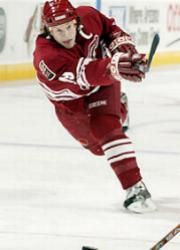 Shane Doan 1996-2017 |  Zbynek Michalek 2005-10, 12-15, 15-17 |
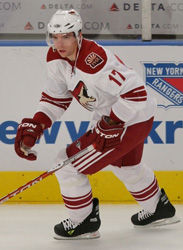 Radim Vrbata 2007/08, 09-14, 16/17 | 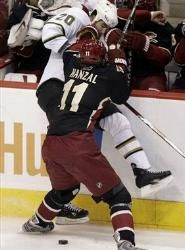 Martin Hanzal 2007-2017 |  Mike Smith 2011-2017 | 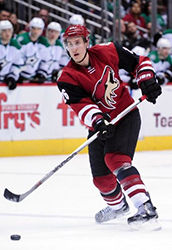 Michael Stone 2011-2017 | 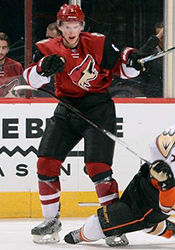 Connor Murphy 2013-2017 | 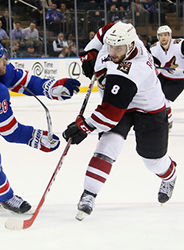 Tobias Rieder 2014-2018 |
 Anthony Duclair 2015-2018 | 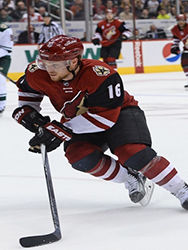 Max Domi 2015-2018 | 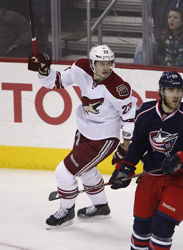 Oliver Ekman-Larsson 2010-Present | 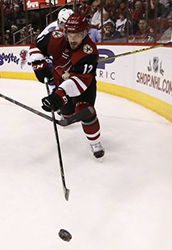 Brad Richardson 2015-Present |  Christian Dvorak 2016-Present | 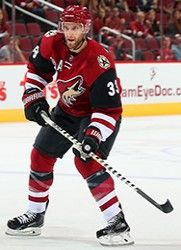 Alex Goligoski 2016-Present |
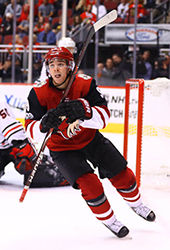 Clayton Keller 2016-Present | 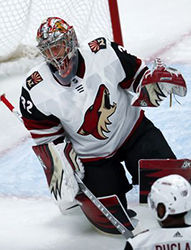 Antti Raanta 2017-Present |  Darcy Kuemper 2017-Present | 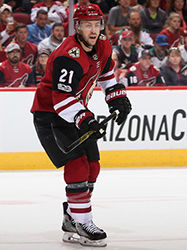 Derek Steppan 2017-Present | 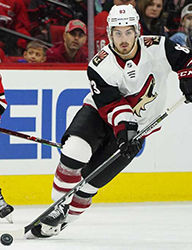 Conor Garland 2018-Present | 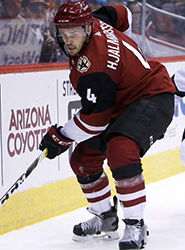 Niklas Hjalmarsson 2018-Present |
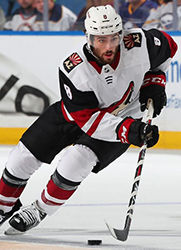 Nick Schmaltz 2018-Present |  Taylor Hall 2019-Present |
